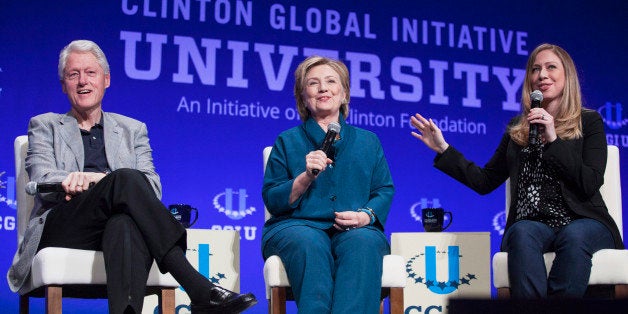
Amid hyperpartisan discussions about the presidential candidates, critiques of their charitable endeavors have stood out.
The critiques of the Trump Foundation entail some clear-cut violations of longstanding rules and customs of private foundations.
It is difficult to understand and critique the Clinton Foundation, because of its size, multi-organization network and variety of programs.
Some critics have made extreme claims that the organization exists solely to enrich its founders or that it's part of a vast criminal enterprise. Others touch on matters of governmental ethics, with accusations that Hillary Clinton engaged in pay-to-play schemes at the State Department, exchanging favorable treatment for donations.
Finally, there are those who make the oft-cited but incorrect claim that the Clinton Foundation spends less than 10 percent of its resources on charity (it spends close to 90 percent). Hidden among such partisan noise, however, are legitimate concerns that warrant a further examination.
And while Clinton no longer plays a role in running the foundation, she is intimately connected to the organization. And for better or worse, its achievements and ethical lapses -- as well as the efforts to correct those failings -- reflect on her and her candidacy.
From our review of the organization and experience in researching nonprofits, we believe that the valid criticisms all point to a problem exhibited by many charities: lax governance. The problems are generally not legal ones. Rather, they set forth questions of ethics, management and messaging.
Some critics have tended to exaggerate the foundation's misdeeds, viewing it as part of some vast criminal enterprise. Such extreme claims obscure the genuine problems.
Andrew Harnik/AP
Who are the donors
All charities that rely on the general public for donations are entering into a de facto partnership with their donors.
Although some may think all donations are good donations, any charity that has found itself in this donor bind knows that it is important to ensure your donors do not send a message antithetical to your mission.
In the Clinton Foundation's case, relying on business partners, foreign donors and foreign governments brings the question to the fore. That some of the governments that are donors have policies that run counter to the foundation's mission raises the stakes. Although this is a major problem for politicians associated with charities, it is a matter that all must consider.
While one cannot entirely eliminate these questions, proactively establishing and communicating a clear and consistent policy can ease concerns. Thus far, the Clinton Foundation has often been reactive, changing its policy toward foreign donations as circumstances change: first permitting donations from a variety of sources, then agreeing to limit foreign government donors, then reopening the door to them, then allowing donations from only specific countries, then agreeing to ban such gifts altogether.
It is this most recent decision, if adhered to strictly, that stands the best chance of assuaging public perception concerns.
Chelsea Clinton, vice chair of the foundation, has made strides to bring in outsiders and other independent voices.
Mark Lennihan/AP
Who has influence
A problem that plagues many nonprofits is that the board and leadership consist of friends, family members and business partners.
Such a circumstance, while natural at the start given the connections of those involved, creates an organization that is at risk of mixing charitable efforts with business and personal endeavors. To combat this possibility, it is critical to establish a culture and controls to ensure the organization is distinct from the individuals involved in it.
A review of the officials at the Clinton Foundation and its affiliates over time reveals a group of long-time Clinton allies and partners. Some are accused of mixing charitable activities with personal connections. Such commingling concerns are particularly salient given a primary activity of the organization has been to convene an annual meeting of business and government leaders to pledge support for a variety of causes.
To her credit, Chelsea Clinton made strides to bring outsiders to leadership positions in the foundation and to conduct audits of internal operations to ensure separation between its activities and the interests of individuals within it.
The fact that some insiders bristled at such efforts should confirm their importance. Unless these efforts are given high priority, the organization and its founders are likely to continue to be dogged by similar accusations.
Conflicts of interest
Conflicts of interest represent a broader concern that arises any time those making decisions for a charity may do so under other, outside pressures.
Those pressures could be from friends, business interests, political goals, etc. To avoid these problems, an organization should establish procedures to identify such potential conflicts and work to assure that even an appearance of one doesn't exist. This is certainly a high bar but one worth aspiring to.
In the Clinton Foundation, the potential for conflicts is unavoidable. The political activities of its founders, the business and government influence of its donors and the matchmaking activities it conducts all open the door. This has led to accusations and speculation about pay-to-play arrangements in which donors to the foundation expect or are promised access or other favorable treatment from the Clintons.
While those remain unproven accusations, like many of the critiques of the Clinton Foundation, they do highlight how even the appearance of a conflict can create concern. Documented cases are the foundation's relationships with donors Frank Giustra and Laureate University, each of whom also had business interests that intersected with State Department decisions. Interestingly, most of the conflicts identified thus far do not implicate significant nonprofit legal issues but rather suggest governmental ethics instead.
Even if such decisions are not truly conflicted, the organization should do all it can to eliminate their appearance. Policies that segregate duties and decision-making power go a long way. For example, a nonprofit could ensure that those who decide on programming are distinct from those who interact with donors and that such a firewall is solidified as part of the culture. That way even if a donor seeks to pressure the organization or its representatives to take certain actions, such pressure doesn't find its way to those who make the decisions.
These issues gave rise to an ethics pact between the foundation and the Obama administration upon Clinton joining the State Department that placed strict limits on activities that could create appearances of a conflict. Lapses in ensuring that it was followed, however, highlight the critical nature of preventing future violations.
The Clintons' relationship with Frank Giustra, a Canadian businessman, has raised questions of conflicts of interest.
Frank Franklin II/AP
Consequences of mission creep
Many organizations expand their mission over time. This can get an organization into a mess quickly if not done with significant forethought. When an organization faces public scrutiny, an expanded mission puts an organization's leaders at risk over their choices and their motivations.
With the Clinton Foundation, "mission creep" has been substantial. It started as an organization to raise funds for the Clinton Library and has over the years added HIV/AIDS, climate change, healthy children, economic development, Haiti earthquake relief and a variety of other initiatives to the mix. It has also employed a variety of approaches, from negotiating for lower drug prices to establishing for-profit/nonprofit hybrid investments to promote growth.
The proliferation of programs and tactics leaves the organization open for criticism of its motives. As an example, the Clinton Global Initiative (CGI), while innovative in its wide-ranging approach of bringing together influential donors with causes and organizations in need of funding, has also raised concerns of mixing business and charitable interests.
While these changes in mission do not implicate legal issues for the Clinton Foundation, they do muddle its purpose. And, if not crafted in a manner to be inclusive of all constituencies of the Foundation, put the organization's good will at risk.
These concerns have not gone unnoticed, as the organization announced the end of CGI in an effort to alleviate worries about its unintended consequences.
The bottom line
Will the questions surrounding the Clinton Foundation have an ultimate impact on the presidential election?
That we don't know. But we can confidently say that the election and the questions it has raised will have a long-lasting impact on the foundation itself. The organization recently announced preliminary plans to reorganize and downsize in the event Clinton is elected president.
And, if a President Clinton emerges from the election on Tuesday, we suggest you look to how the foundation reorganizes as a signal of the seriousness she will place on effective governance and maintaining public trust.
Philip Hackney, James E. & Betty M. Phillips Associate Professor of Law, Louisiana State University and Brian Mittendorf, Fisher College of Business Distinguished Professor of Accounting, The Ohio State University
This article was originally published on The Conversation. Read the original article.
